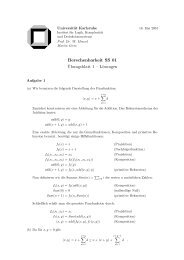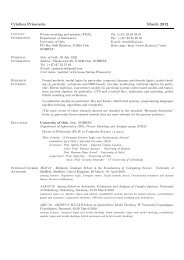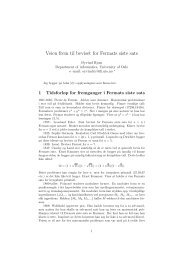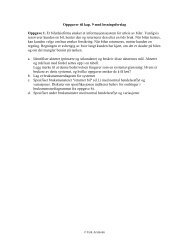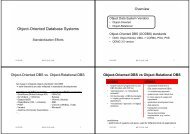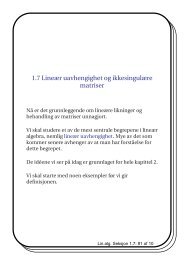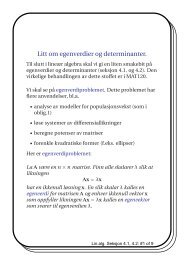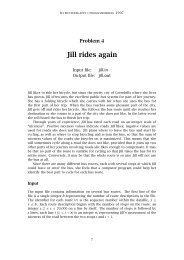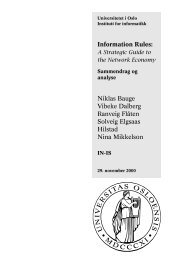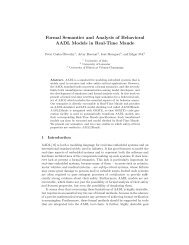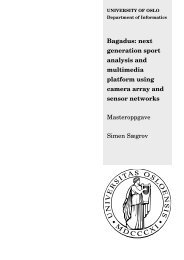Timed CTL Model Checking in Real-Time Maude⋆ - IfI
Timed CTL Model Checking in Real-Time Maude⋆ - IfI
Timed CTL Model Checking in Real-Time Maude⋆ - IfI
Create successful ePaper yourself
Turn your PDF publications into a flip-book with our unique Google optimized e-Paper software.
10 D. Lepri, E. Ábrahám, and P. Cs. Ölveczky<br />
– the set of states reachable from t0 <strong>in</strong> the rewrite theory R is f<strong>in</strong>ite, and<br />
– given a pair of reachable states t and t ′ , the number of one-step rewrites of<br />
r<br />
the k<strong>in</strong>d t −→ t ′ <strong>in</strong> R is f<strong>in</strong>ite.<br />
As mentioned above, real-time rewrite theories generally conta<strong>in</strong> a time-nondeterm<strong>in</strong>istic<br />
tick rule, but s<strong>in</strong>ce <strong>Real</strong>-<strong>Time</strong> Maude executes such theories by<br />
apply<strong>in</strong>g a time sampl<strong>in</strong>g strategy σ, our model checker does not analyze R but<br />
the executable theory Rσ <strong>in</strong> which the time sampl<strong>in</strong>g strategy transformation<br />
has been applied. Thus, we associate a timed Kripke structure not to R, but<br />
to Rσ , and hence the third requirement is satisfied by all but the most esoteric<br />
cases; <strong>in</strong>deed, the tick rules <strong>in</strong> all <strong>Real</strong>-<strong>Time</strong> Maude applications we have seen<br />
are determ<strong>in</strong>istic, <strong>in</strong> the sense that there is at most one one-step tick rewrite<br />
r<br />
t −→ t ′ from any state, when the time sampl<strong>in</strong>g strategy is taken <strong>in</strong>to account.<br />
We denote by T K(R, t0)Π the timed Kripke structure associated to R which<br />
is restricted to states reachable from t0, and for states t reachable from t0 we<br />
write R, LΠ, t |= ϕ for T K(R, t0)Π, t |= ϕ.<br />
4 Sound and Complete T<strong>CTL</strong> <strong>Model</strong> <strong>Check<strong>in</strong>g</strong> for<br />
<strong>Real</strong>-<strong>Time</strong> Maude<br />
As mentioned above, for dense time doma<strong>in</strong>s, <strong>Real</strong>-<strong>Time</strong> Maude only analyzes<br />
those behaviors obta<strong>in</strong>ed by apply<strong>in</strong>g the tick rules accord<strong>in</strong>g to a selected<br />
time sampl<strong>in</strong>g strategy. The paper [29] specifies some conditions on a real-time<br />
rewrite theory R and on the atomic propositions that ensure that model check<strong>in</strong>g<br />
R maxDef (r) , i.e., us<strong>in</strong>g the maximal time sampl<strong>in</strong>g strategy, is a sound and<br />
complete model check<strong>in</strong>g procedure to check whether all behaviors <strong>in</strong> the orig<strong>in</strong>al<br />
model R satisfy an untimed LTL formula without the next operator.<br />
For example, if<br />
– no application of a tick rule changes the valuation of the atomic propositions<br />
<strong>in</strong> a formula (this requirement almost always holds <strong>in</strong> real applications, s<strong>in</strong>ce<br />
the only values changed by ticks are clock and timer values that usually do<br />
not appear <strong>in</strong> the formula);<br />
– <strong>in</strong>stantaneous rewrite rules can only be applied after maximal tick steps or<br />
after apply<strong>in</strong>g an <strong>in</strong>stantaneous rule,<br />
then model check<strong>in</strong>g R maxDef (r) gives a sound and complete model check<strong>in</strong>g<br />
procedure for R. 5 This result yields a feasible sound and complete model check<strong>in</strong>g<br />
procedure for many useful (dense-time) systems, that <strong>in</strong>clude many systems<br />
that cannot be modeled as, e.g., timed automata.<br />
Unfortunately, this completeness result does not carry over to timed temporal<br />
logic properties. Consider for example the T<strong>CTL</strong> formula ϕ = E F≥1 (E p U≥2 q).<br />
5 The requirements <strong>in</strong> [29] are weaker than described here; e.g., the valuation of the<br />
atomic propositions may change once <strong>in</strong> a sequence of maximal tick rewrites.



